Menu
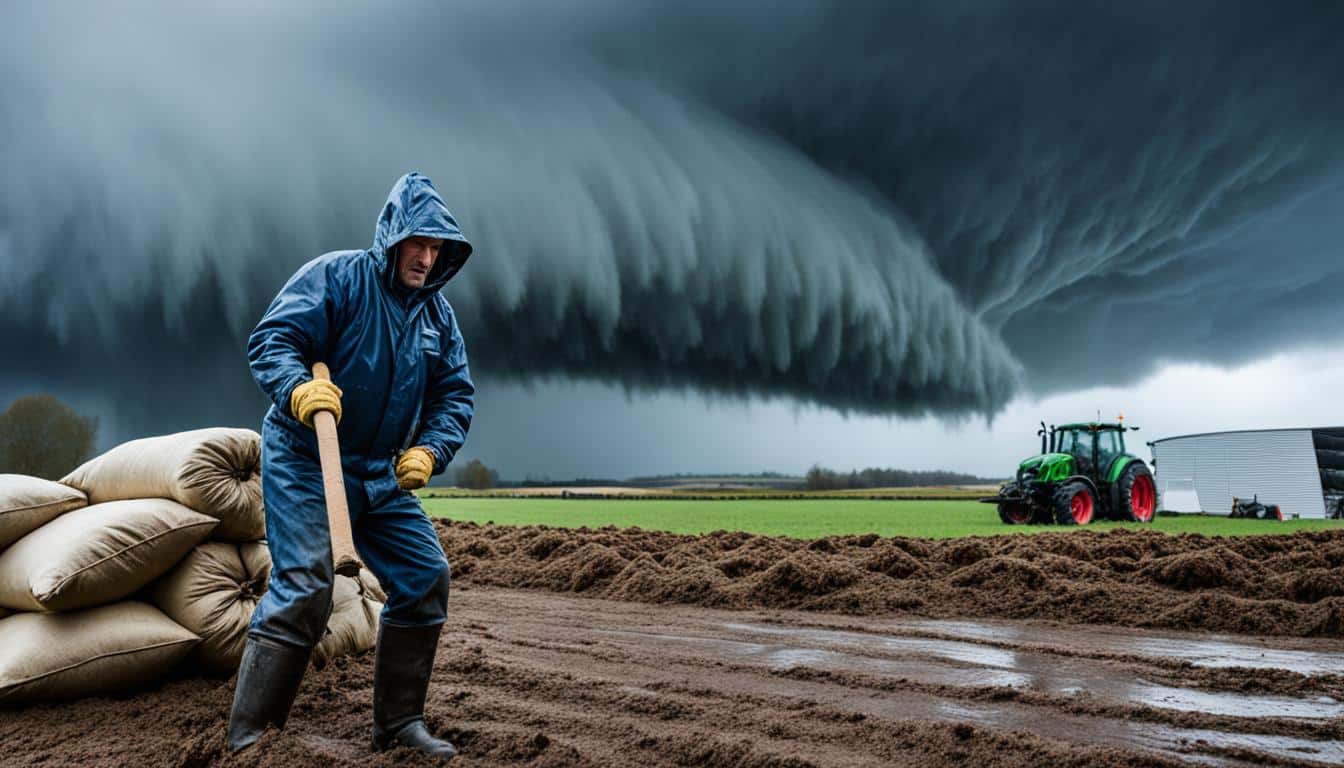
Did you know that tornadoes, floods, droughts, and wildfires can harm farm equipment and land each year? John Grant, as an Agribusiness Underwriting Manager, recommends farm owners prepare for bad weather. Taking photos and making lists of everything on your farm is a crucial first step. This helps when you need to make a claim but also ensures you have the right insurance and know what to protect.
It’s key to realise how important emergency farm weather planning is. It helps keep farms safe from severe weather’s bad effects. For a hundred years, many farm accidents could have been avoided. This shows why it’s vital to be ready in dealing with bad weather on the farm.
Having a well-made emergency plan is critical. It can cut down on damage from disasters, helping the farm stay profitable and grow. A good emergency plan is like buying insurance for your farm. It protects your hard work and keeps your business going.
It’s important to know where everyone is after an emergency evacuation. Make a list of everyone who works on or is connected to the farm for emergencies. This list helps make sure everyone is safe and that things get back to normal as soon as possible. Also, keeping a good record of what’s on the farm is a must. This record helps protect your farm from different disasters.
Protecting animals during bad weather is highlighted by the USDA APHIS. During the 1993 Midwest floods, having emergency plans saved many animals. They advise having plenty of shelter for each animal. It should be four times bigger than the animal to keep them safe during tough times.
It’s smart to check your emergency plans regularly, says the USDA APHIS. This practice saves time and stress when real emergencies hit. They also recommend picking a safe spot to keep your important farm papers. This way, your essential info is protected from harm.
“A well-prepared emergency plan can mitigate the impact of severe weather and secure the long-term sustainability of farming operations.” – USDA APHIS
| Preparedness Measures | Key Benefits |
|---|---|
| Active Emergency Action Plan | Minimises damage during disasters |
| Documenting Procedures | Ensures safety and accountability |
| Inventory System | Tracks farm assets effectively |
| Regular Plan Re-evaluation | Saves valuable time during emergencies |
| Offsite Storage of Documents | Protects critical farm information |
Before severe weather strikes, it’s key to take stock of your farm. This means noting every piece of equipment and the whole property. By doing this, you’re ensuring all your assets are safe and accounted for. It gives you a detailed list of everything you own.
Making a list of your farm gear includes recording its details, where it’s kept, and its value. This not only helps day-to-day but is vital when making insurance claims. Detailed notes speed up your claim process. This way, you can get the right money quickly and keep farming.
Adding photos to your inventory makes it stronger. Take pictures of your equipment, land, and animals. These photos give undeniable proof of what you have. They are key when sorting out insurance claims. They show clearly what’s been lost or damaged.
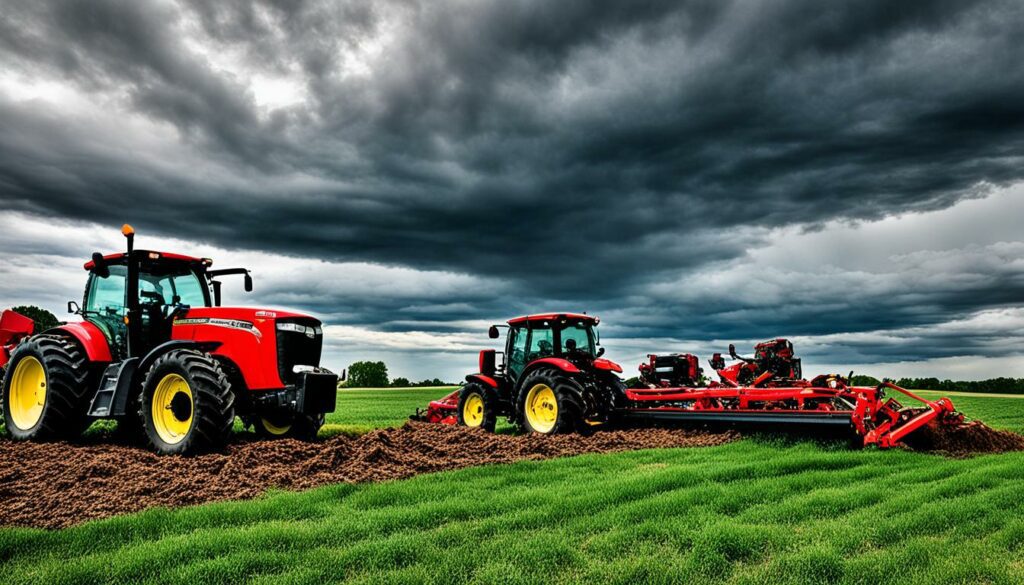
Staying in touch with your insurance agent helps. Having an annual check-in with a COUNTRY Financial Insurance Agent is smart. It ensures your coverage matches what you actually have. This also includes any new animals or tools. Regular talks make dealing with insurance simpler, keeping your farm secure.
| Recommended Preparations for Extreme Weather | Action Items |
|---|---|
| Taking inventory of farm equipment and property | Document details, value, and location of assets |
| Using photos for records | Capture high-quality images of equipment and livestock |
| Communicating with insurance agents | Schedule annual reviews with agents to update coverage |
Employee safety on farms is key in emergency plans. Good preparation and clear communication reduce harm and save lives in emergencies.
It’s vital to review emergency evacuation plans often. This ensures everyone knows the best ways to escape. Drills for various emergencies like fires or floods make farms safer.
It’s important to assign roles for a quick response during emergencies. Giving specific tasks to employees boosts their confidence. This helps make the farm a safer place.
Having a detailed farm emergency contact list is critical. It should list the farm owner, family, and key services. An up-to-date list means help can be reached fast, reducing damage.
By planning well and practicing, employee safety on farms improves. This, along with accurate farm emergency contact lists, creates a safe working environment.
Farmers must always check that their farm insurance is current and complete. It’s smart to review your farm insurance often. This can help you spot any gaps in coverage and let you add more protection if needed. Knowing how to make a claim can make things easier if there’s a problem.
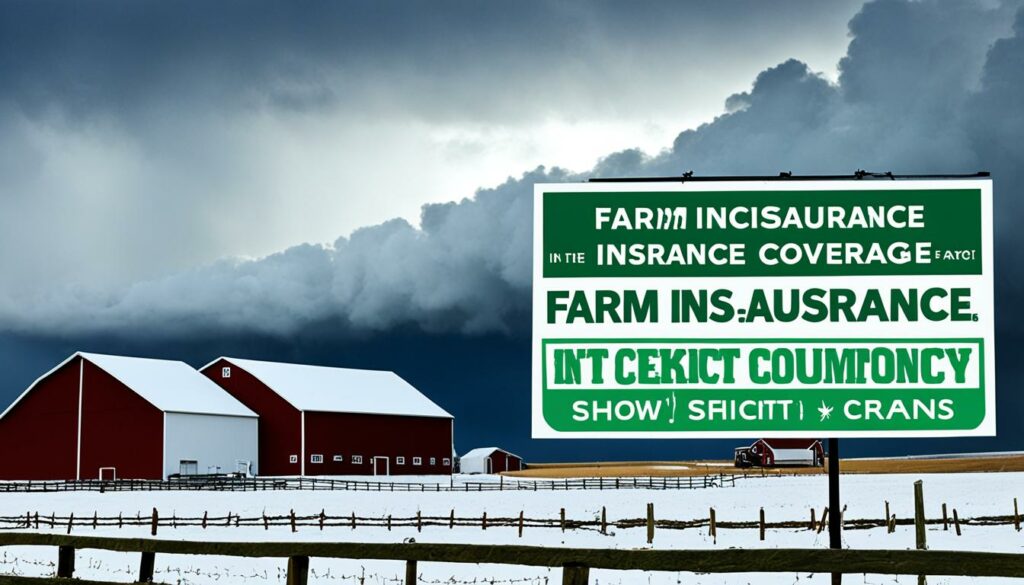
Meeting with your insurance agent once a year is a must. You’ll talk about any new equipment, changes to your land, or how you run your farm. This could show where you might be underinsured. Keeping your insurance up to date like this helps you stay secure.
This knowledge not only makes dealing with your insurance company easier. It also means your farm can recover more quickly after a setback.
Extreme drought makes keeping farm tools working more important than ever. This regular farm equipment maintenance keeps things running when the weather is rough. It’s key for farming success during hard times.
Generators step in during power cuts to save the day. It’s vital to often check them to make sure they’ll work when we need them. A check on the fuel lines, batteries, and parts is a must. Otherwise, we could lose precious work hours, especially in key moments.
In tough weather, keeping a good fuel supply is crucial. You need enough liquid propane or other fuels to go on for a few days. Having enough can lower downtime and keep farming on track, even in bad weather.
Drought affects farms in many ways, from less grass to lots of dust. This means more work for farmers to maintain their gear. It shows why taking care of farm equipment maintenance and generator servicing is very important.
To tackle heat waves on farms, a mix of strategies is needed. These can help lower risks to animals and crops. Let’s look at a few ways to keep farm work going strong even in the hottest times.
Farmers often use timed fans and sprinklers to keep barns cool. These tools kick in when it gets too hot, making the air better for animals. It’s a smart way to prevent heat stress in livestock.
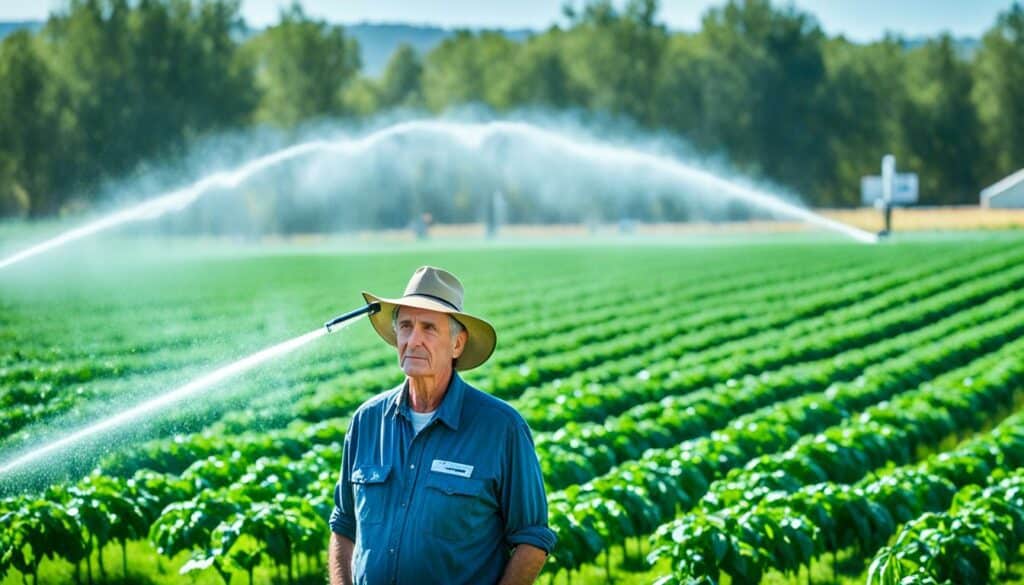
The design of barns is key. Big doors on opposite sides help air flow naturally. This, together with cooling systems, keeps the barns just right for animals.
Today, farmers use tech to fight the heat. With tools like the U.S. Meat Animal Research Center’s heat stress forecast, they plan ahead. This data helps them make choices that safeguard their farms and livestock.
Creating shade for crops is vital. Shade cloths come in different types to protect against too much sun. Also, planting cover crops helps keep the soil and plants healthy, even in intense heat.
Winter’s arrival signals a need for extra farm work. With temperatures dropping, keeping livestock healthy and warm is vital. Let’s explore important steps for winter farm prep.
In wintertime, livestock need more food to stay warm. For example, cattle might double their food intake in cold spells. High-quality feed is a must to meet their energy needs and keep them healthy.
Winter shelters should be strong against wind and snow. Animals need space to move and stay protected. Insulated barns and windbreaks are key to prevent hypothermia and frostbite.
Winter brings a challenge with freezing water. However, it’s crucial to keep water sources available to prevent dehydration. Heated troughs and de-icers help stop water from turning to ice. Breaking ice or changing water keeps it flowing for livestock’s health.
Good preparation is key to keeping animals safe and well in winter. More feed, strong shelters, and water solutions are vital. This way, animals stay healthy despite the cold.
Tornadoes bring a real threat to farms, requiring quick decisions. It’s important to have well-thought-out plans to keep animals and crops safe. The US sees about 1,000 tornadoes each year, causing serious harm and damage. This makes tornado preparation a must on farms.
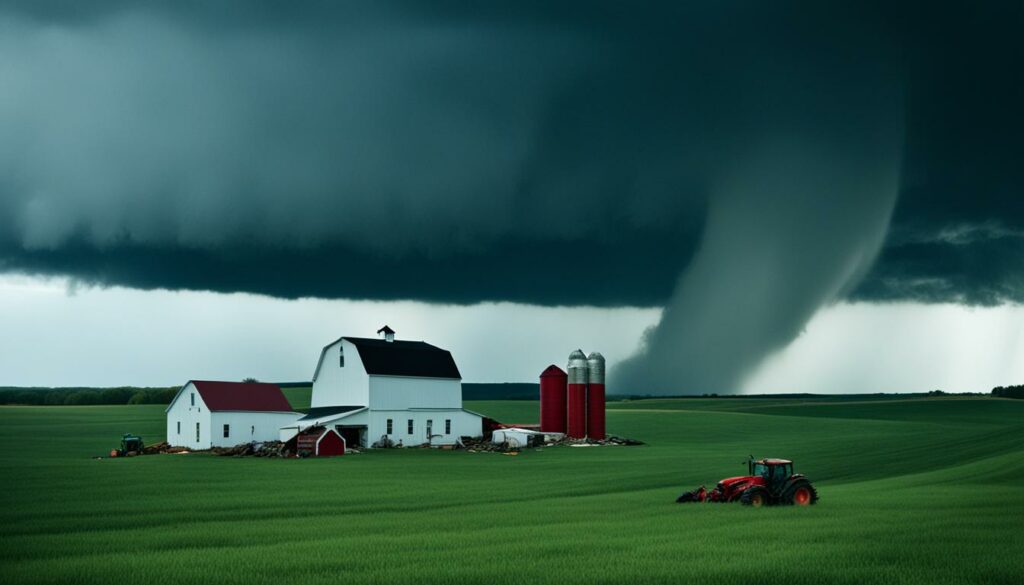
Choosing if animals should be moved is a key part of a safety plan. Relocating can lower the chance of livestock getting hurt. It’s vital to move them to strong shelters if there’s a risk. Don’t forget to mark your animals for easy identification.
Keeping backup supplies ready is essential after a tornado. This means having a generator filled with propane and making sure your tractors have enough fuel. Store extra feed, water, and medicine. It’s also smart to regularly check your farm insurance to spot any missing coverage.
Farmers should take steps to protect their crops from tornadoes. Make sure your crops are strong and tidy up the fields to reduce flying debris. Adding windbreaks can help shield your crops. And it’s crucial to have plans in place for everyone’s safety if a tornado hits.
To sum up, being ready for tornadoes means having strong safety plans for animals, keeping backup supplies, and protecting your crops. This preparation is vital to bounce back quickly after a tornado hits.
Farmers need to make their crops ready for all kinds of weather. They can use various techniques to protect their crops. This helps in dealing with extreme weather and makes farming sustainable. Farmers focus on keeping the soil moist and healthy. This way, their plants can better resist bad weather.
Shade cloths are a top choice for crop protection. They shield plants from too much sun and heat. This helps the soil stay moist. Plus, it creates a cooler area for plants to thrive.
Cover crops like legumes and grasses are important. They cover the soil, making it hard for wind and rain to wash it away. They make the soil richer and hold more water. This keeps the soil in good shape for growing crops even in extreme weather.
Keeping the soil healthy is a key part of farming well in all weathers. Farmers should add organic materials to the soil. This makes the soil able to hold more water and help plants grow strong. Healthy soil also makes plants tougher against cold, rain, and droughts.
The Conservation Tillage and Technology Conference helps farmers learn how to care for the land better. It offers advice on managing nutrients, soil, and water. These techniques are part of smart, sustainable farming.
Lots of talks at the conference focused on getting ready for droughts and hard times, like what happened in 2012. Farmers learned about new types of plants that can survive tough weather. They also found that planting corn and soybeans in turns is a good way to deal with drought.
| Topic | Focus |
|---|---|
| Nutrient Management | Maintaining optimal soil nutrient levels |
| Soil and Water Management | Enhancing soil moisture retention |
| Crop Scouting | Identifying crop stress early |
| No-Till Technology | Reducing soil disruption |
| Seeding Technology | Optimising seeding rates for yield |
Setting up an agricultural emergency action plan is key for farm disaster preparedness. In states like Minnesota, with its share of challenges including tornadoes and floods, this step is extra important. This plan should include a detailed map of the entire farm, showing all important areas. This helps a lot when quick action is needed during emergencies.
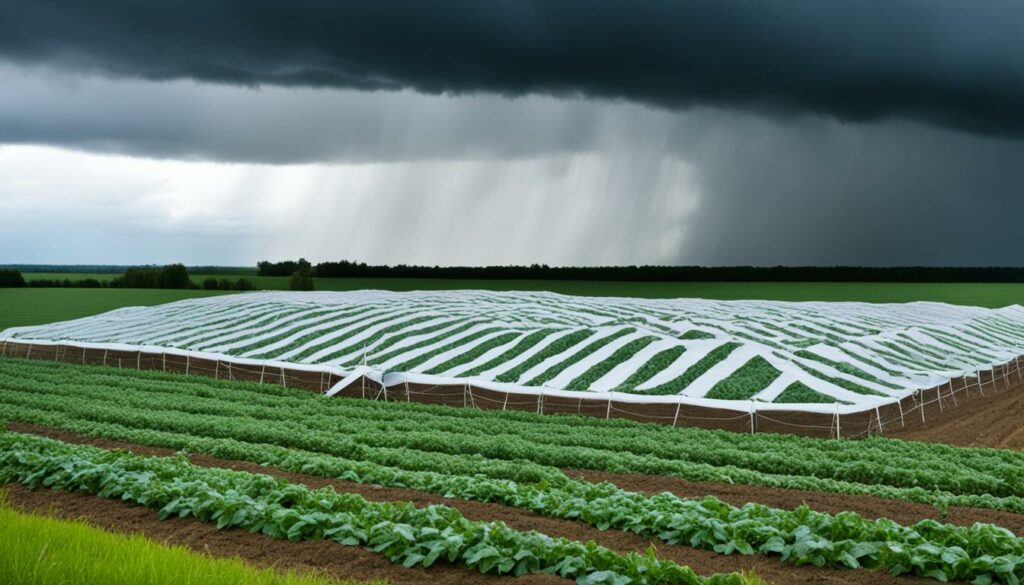
Having an up-to-date list of your animals, crops, and equipment is vital for being ready. Make sure to list important contacts too. Include numbers for vets, emergency services, and those who provide farm essentials. This helps everyone know who to call in a crisis.
Checking your insurance and making sure you’ve got necessary supplies is also crucial. It’s a good idea to have two plans ready, one for staying put and one for leaving. Think about how you’ll move your animals if you have to go. And don’t forget about things like backup power and the safe storage of dangerous materials.
When it comes to moving your animals, plan ahead to keep everyone safe. Know where they can go and how to get them there. This type of preparation reduces the risks of an unplanned evacuation.
It’s also important to be ready for medical accidents, like heart attacks or allergic reactions. Make sure all farm staff knows first aid. This can make a big difference in an emergency.
If there’s a gas leak or someone gets stuck, there are special steps to follow. Be sure everyone knows what to do. A quick, correct response is crucial to avoid making the situation worse.
Be ready for a range of storms, from hurricanes to winter blizzards. This means checking your gear and securing your farm. Also, keep in touch with neighbours and weather reports. They can help you stay safe and ready.
The Ready Virginia app and local emergency services are great for advice and alerts. Use these to plan better. Also, take tips from emergency departments for even more detailed help.
Making farms more resilient involves using both new tech and traditional farming ways. The International Center for Tropical Agriculture and CGIAR Research Program team up to help. They’ve created ICT tools that over ten partners in Colombia and Honduras use. These tools help farmers make smart choices about the weather.
Using AI is key to dealing with disasters in farming. It helps predict long-term issues like rising sea levels and sudden dangers like hurricanes. Google’s Flood Hub warns about floods using AI, helping farmers keep safe.
Simple farming practices are also vital for farm resilience. Things like growing different crops together and changing where crops grow help deal with a changing climate. Better ways to water crops and collect rain also mean farms can cope without waiting for the rain.
Having healthy soil is crucial after disasters hit. By planting certain crops and adding natural fertilizers, soil stays full of water and helps crops bounce back. This makes farms able to handle bad weather.
| Strategies | Benefits |
|---|---|
| Advanced ICT Tools | Informed climate-smart decisions |
| AI & Hazard Forecasting | Improved preparation and mitigation |
| Basic Agronomic Techniques | Reduced losses from extreme weather |
| Intercropping & Rotation | Enhanced adaptation to climate change |
| Improved Irrigation | Optimised water usage |
| Soil Health Practices | Better resilience and crop growth |
| Precision Agriculture | Real-time data for informed decisions |
Efficiently using water is key for farms. With tools like drones, farmers can get quick updates on their soil and plants. This helps them use resources wisely by making educated choices.
Good farm communication in emergencies is crucial. Having updated contact lists and clear plans are key. It’s important to list everyone linked to the farm and emergency services contacts.
Having detailed contact lists is vital. Include numbers for vets, emergency offices, and insurance agents. Post these lists in easy-to-find spots for fast help.
Clear plans make sure everyone knows what to do in an emergency. They help lower the time for a response and improve teamwork. It’s smart to review these plans regularly with your team.
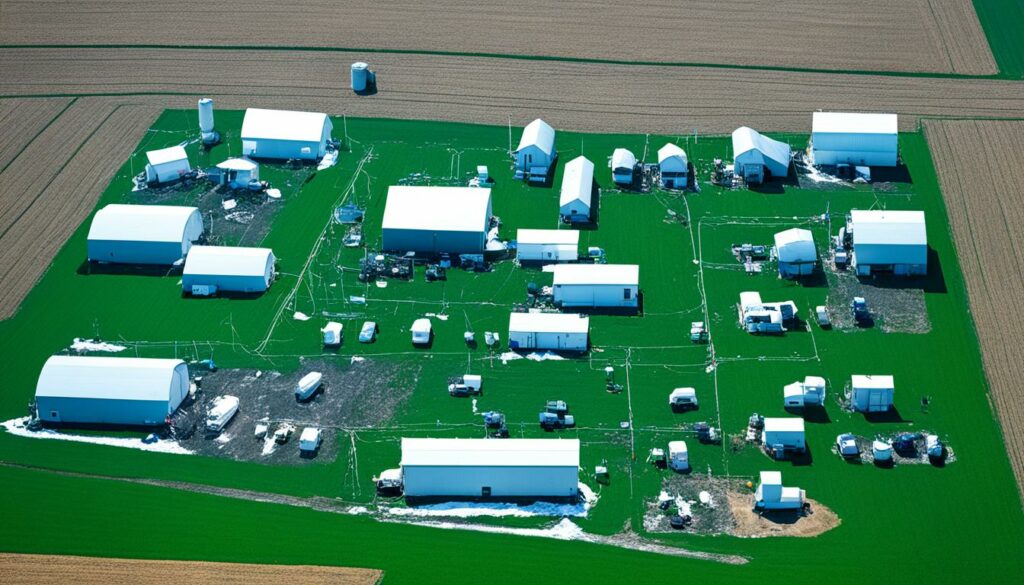
Strong planning helps protect your farm from disasters. Think about the likely emergencies in your area. A good contact list and smart communication plans will keep your farm safe.
| Parameter | Percentage (%) |
|---|---|
| Farms with emergency supply kits for families | 64% |
| Farms listing hazardous substances | 72% |
| Farms with emergency phone numbers | 89% |
| Farms with established phone trees for employees | 55% |
Farm recovery after disasters can be tough, especially when it comes to dealing with debris. The floods on the Saguenay River in Quebec in 1996 and the Red River floods in Manitoba in 1997 were hard on farm. In 1998, the Eastern Canada Ice Storm became the costliest natural disaster in Canada’s history, stressing the need for organised farm cleanup.
With climate change, natural disasters are happening more often. Farmers across Canada face various calamities that can leave tons of debris. This debris slows down recovery if not managed quickly.
Start by knowing the local rules for getting rid of waste, especially hazardous items. Following these laws keeps the environment and workers safe during cleanup. Having a plan for debris makes cleanup faster, lessening its impact on farm operations.
Learning from places like the Southeastern United States can be helpful. This area sees a lot of hurricanes. They’ve found that preparing and keeping good records is key. This helps with insurance later on, making recovery easier for farmers.
In the end, handling debris well is vital for farm recovery. Being prepared and knowing what to do can reduce the effects of disasters. This ensures farms can bounce back, staying strong and sustainable.
Getting ready for extreme weather is vital on farms. It helps protect equipment, property, and animals from tornadoes, floods, and more. This readiness keeps farms profitable and sustainable by reducing risks and coping with bad weather.
An emergency plan includes detailed notes and photos of what you own. Talk to your insurance company often, and make sure employees know what to do. They should have escape paths and key contacts for emergencies.
Start by listing everything you have and where it is. Take photos, as they help with insurance claims. Update your list when things change on your farm.
Talk to your insurance agents regularly. Check your policy once a year and tell them about your farm’s updates. Knowing how to claim insurance helps after a disaster.
Show your team how to get out in emergencies and what they need to do. Make sure they have all the important contacts. Drill with them so everyone is ready for unexpected events.
Check your equipment and do maintenance often. This is especially important for items like generators. They should be ready and filled with fuel in case of bad weather.
To fight heatwaves, use fans and sprinklers for animals, and design barns for air flow. Then, use technology to track heat stress and add shade for crops and livestock.
During snow and cold, increase animal food and provide shelters. Always keep water available using heaters. This keeps your animals safe and healthy in cold spells.
In a tornado, think fast about moving animals to safer places. Stock up on essentials for them after, and make crops stronger before a storm by deepening their roots.
To safeguard crops, use shade to moderate temperature extremes and sow cover crops for moisture. Always keep an eye on farming methods to keep soil healthy and crops strong in any weather.
A good plan covers all buildings and what’s in them. It lays out how to act in emergencies and who does what. Keep it updated and known by all to act fast when needed.
To make your farm tougher against bad weather, build strong structures. Diversify your crops and keep up with new farming techniques and technology. This improves your farm’s ability to brave any weather.
Keep updated lists of important contacts and emergency numbers. Make sure everyone knows how to share important information in a crisis.
Plan your clean-up for after a disaster and be aware of local waste rules. Keep the environment safe by properly getting rid of chemicals and other dangerous items. This is key for a smooth and eco-friendly clean-up.